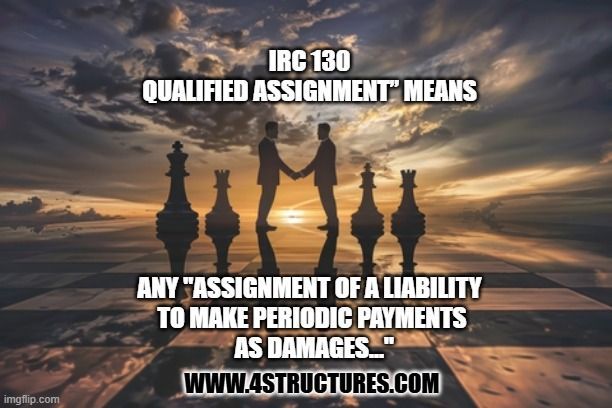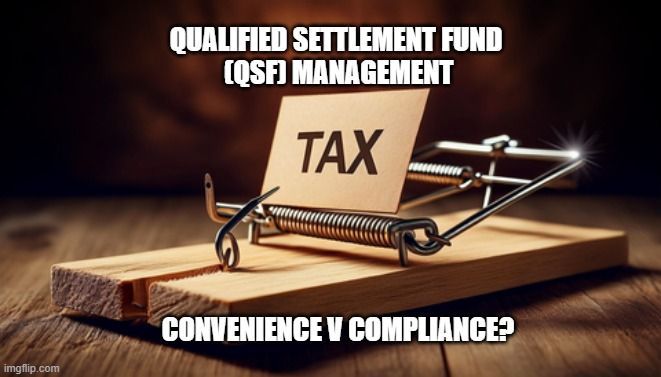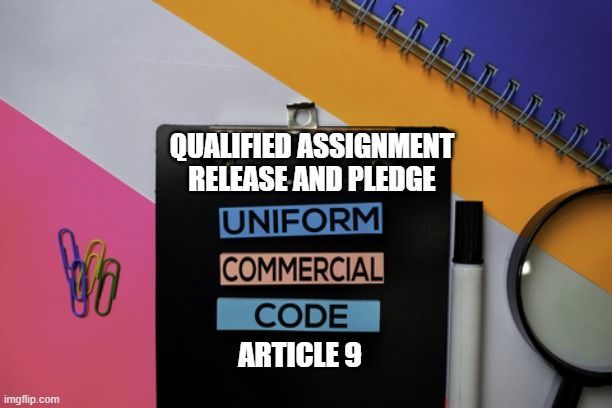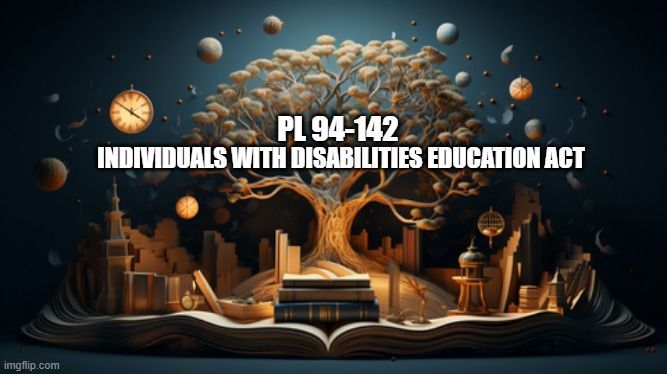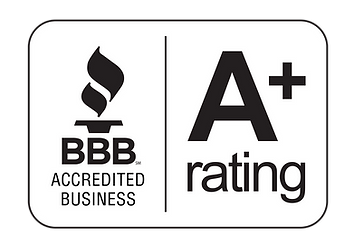What is a Qualified Assignment?
Why Most Insurers Won't Structure Without One

What is a qualified assignment with a structured settlement?
A qualified assignment enables a Defendant, Insurer, or Qualified Settlement Fund, to achieve a complete novation of the future periodic payment claim when a structured settlement is established, through a substitution of obligors. This is important to Defendants, or Insurers because the total payments from a structured settlement will exceed the cost of the structured settlement. A structured settlement is a useful settlement tool for all parties, but without a qualified assignment the Defendant or insurer has contingent liability in the event of insolvency of the annuity issuer that could exceed the settlement funding amount.
A qualified assignment is a transfer of a contractual obligation to make future periodic payments, which satisfies the requirements of Internal Revenue Code (IRC) §130. In a structured settlement agreement, the original obligor (the defendant, insurance carrier for the defendant, or the trustee of an IRC 468B qualified settlement fund), assigns its obligation to make the future periodic payments defined in the settlement agreement to a "qualified assignment company".
Today it is very rare that a structured settlement is established as part in a personal injury, wrongful death or workers compensation settlement without a qualified assignment.
PRO-TIP
Only payments which represent damages for personal injury, physical sickness, wrongful death and payments for workers compensation may be assigned via a qualified assignment.
Qualified Assignment in the Internal Revenue Code
According to IRC 130(c), the term "qualified assignment" means any assignment of a liability to make periodic payments as damages (whether by suit or agreement), or as compensation under any workmen’s compensation on account of personal injury or sickness (in a case involving physical injury or physical sickness)—
(1) if the assignee assumes such liability from a person who is a party to the suit or agreement, or the workmen’s compensation claim, and
(2) if—
(A)such periodic payments are fixed and determinable as to amount and time of payment,
(B)such periodic payments cannot be accelerated, deferred, increased, or decreased by the recipient of such payments,
(C)the assignee’s obligation on account of the personal injuries or sickness is no greater than the obligation of the person who assigned the liability, and
(D)such periodic payments are excludable from the gross income of the recipient under paragraph (1) or (2) of section 104(a).
The determination for purposes of this chapter of when the recipient is treated as having received any payment with respect to which there has been a qualified assignment shall be made without regard to any provision of such assignment which grants the recipient rights as a creditor greater than those of a general creditor.
(d) Qualified funding asset
For purposes of this section, the term “qualified funding asset” means any annuity contract issued by a company licensed to do business as an insurance company under the laws of any State, or any obligation of the United States, if—
(1) such annuity contract or obligation is used by the assignee to fund periodic payments under any qualified assignment,
(2) the periods of the payments under the annuity contract or obligation are reasonably related to the periodic payments under the qualified assignment, and the amount of any such payment under the contract or obligation does not exceed the periodic payment to which it relates,
(3) such annuity contract or obligation is designated by the taxpayer (in such manner as the Secretary shall by regulations prescribe) as being taken into account under this section with respect to such qualified assignment, and
(4) such annuity contract or obligation is purchased by the taxpayer not more than 60 days before the date of the qualified assignment and not later than 60 days after the date of such assignment.
Does " fixed and determinable" mean that payments are fixed at a certain amount and cannot change?
The IRS has concluded in several Private Letter Rulings over two decades, obtained by structured settlement annuity issuers in support of product innovation, that fixed and determinable could be based on an objective formula
In IRS PLR-202127039 (published July 9, 2021) in response to a request from American General Life Insurance Company in support of its Interest Linked Structured Settlement Annuity, the IRS ruled:
- The periodic Subject Payments of damages that Minor will receive are fixed and determinable as to amount and time of payment within the meaning of § 130(c)(2)(A) even though they are calculated pursuant to an objective formula based on the performance of 10-year United States Treasury Bond Yield Rate. In addition, the other requirements of § 130(c) have also been met. Accordingly, the assignment entered into pursuant to the Assignment Agreement is a qualified assignment under § 130(c).
2. The Annuity purchased by the Assignee qualifies as a qualified funding asset under § 130(d).
In IRS PLR 201435006 (published on August 29, 2014) in response to a request by Pacific Life to support its Index Linked Annuity Payment Adjustment Rider (ILAPA), the IRS ruled that:
1. The periodic payments of damages that Claimant will receive are fixed and determinable as to amount and time of payment within the meaning of § 130(c)(2)(A) even though they are calculated pursuant to an objective formula based on the performance of the S&P 500 Index.
2. The Structured Settlement Indexed Annuity which Assignee will acquire from
either Issuer 1 or Issuer 2 will not fail to qualify as a qualified funding asset under
§ 130(d) solely by reason of annuity’s variable payments.
3. The possibility of a commutation by Claimant pursuant to the Notice of Hardship
Conversion will not affect whether the structured settlement assignment satisfies
the requirements of a qualified assignment under § 130(c).
4. The annuity purchased by Assignee will not fail to be a qualified funding asset
under § 130(d) by reason of the Notice of Hardship Conversion.
In PLR 199943002 (1999), obtained by MetLife to support a variable annuity structured settlement product it was introducing, the IRS concluded:
I1. The periodic payments of damages that Claimant will receive are fixed and determinable as to amount and time of payment under § 130(c)(2)(A) even though they are calculated pursuant to an objective formula based on the performance of the Standard & Poor’s 500 Stock Index and/or a mutual fund portfolio designed to achieve long-term growth of capital and moderate current income;
2. The annuity Assignee will acquire from Issuer will not fail to qualify as a qualified funding asset under § 130(d) solely by reason of the annuity’s variable payments, which are reasonably related to the periodic payments under the qualified assignment; and 3. Claimant’s physical possession of the annuity solely to perfect, under applicable state law, a security interest in the annuity used to fund the periodic payments will not cause Claimant to receive income in the year Claimant takes possession of the annuity contract if the defendant's assignment to Assignee is a qualified assignment under § 130(c).
What is a qualified assignment company?
Generally, a qualified assignment company is a special purpose company, which does little more than hold structured settlement annuities or United States Treasury obligations as a "qualified funding asset" to back up the periodic payment obligations it assumes from Defendants, Insurers or qualified settlement fund administrators/trustees. A qualified assignment company may actually be an insurance company itself, but most qualified assignment companies are not insurance companies. When an annuity is used as a qualified funding asset, the qualified assignment company is usually related to the life insurance company issuing the structured settlement annuity. In such cases, the qualified assignment company typically purchases an annuity from the related life insurance company as a qualified funding asset pursuant to IRC 130(d).
Types of Qualified Assignment Agreements
1. Qualified Assignment (QA)
A legal instrument executed by Defendant, Insurer or Qualified Settlement Fund Trustee and Qualified Assignment Company
Also referred to as a two-party qualified assignment.
2. Qualified Assignment and Release (QAR)
A legal instrument executed by Defendant, Insurer or Qualified Settlement Fund Trustee, Qualified Assignment Company and Releasing Party. Also referred to as a three-party qualified assignment
3. Qualified Assignment Release and Pledge (QARP)
A legal instrument executed by Defendant, Insurer or Qualified Settlement Fund Trustee, Qualified Assignment Company and the Claimant-Secured Party. Used where there is a desire to give the payee a security interest in the annuity contract.
Which Qualified Assignment Agreement to Use?
While the QA works, it is no longer the standard of practice. While it affects the plaintiff, the QA's two-party process is not inclusive of the plaintiff. It is between the insurer and the assignment company. With the next two options, the QAR and QARP a plaintiff signature and review is required.
Important Note
Where the Claimant-Secured Party is different than the Releasing Party an additional signature on the QARP may be required.
For example, a minor plaintiff who will be adult when payments are made but is represented by a parent or guardian at the time of settlement. Another example could be where the payee is a Special Needs Trust (Supplemental Needs Trust, in New York), and the trust is the secured party, but the plaintiff is releasing the claim
The following video about structured settlement documentation may be helpful to those who wish to learn more. We also encourage readers to call John Darer of 4structures.com LLC at 888-325-8640 and tap his "encyclopedic knowledge" on the topic.
Last updated July 8, 2025
